Peter MALONE
Saturday, 18 September 2021 19:54
Starlet

STARLET
US, 2012, 103 minutes, Colour.
Dree Hemingway, Besedka Johnson, Stella Maeve, James Ransone.
Directed by Sean Baker.
The title refers to the central character as well as to her pet Chihuahua.
Starlet is a surprisingly interesting film which draws us to its central characters. There needs to be a caution because the Jane, central actress, works in the pornography industry in Los Angeles, and there are scenes of drugs, the setting up of locations for filming and an actual, not simulated, sex episode (where Dree Hemingway has a body double for the scenes).
The film is small budget, has a feeling of authenticity with its plain/realistic camera work, focusing on Jane (Dree Hemingway, the daughter of Mariel Hemingway), her life in her apartment, sharing with Melissa (Stella Maeve), getting some jobs but having a lot of free time. When she goes to a garage sale and buys what she thinks is a vase but which is really an elaborate thermos flask, she clashes with the owner, Sadie (Besedka Johnson), but later finds $10,000 in it. Her feelings and her conscience urge her to go back to see Sadie about the money, but what happens is that she begins to give Sadie lifts home from the supermarket, goes into her house for conversation, looks at her beautiful garden, goes to bingo games, and the two become friends, Sadie telling her life story about her gambler husband and the early death of her daughter.
A dramatic point comes when Jane decides to buy first-class plane tickets to Paris for Sadie and herself, Sadie being reluctant, Melissa visiting Sadie to tell her that Jane was no friend, but Jane making a bet at the bingo games, buying many cards, but Sadie actually winning. And the bet was whether the two would go to Paris or not.
Besedka Johnson had not made any films and took on this role at the age of 85. She is spontaneous in her responses rather than performing, and most persuasive.
1. The title? Jane and her career? Her pet Chihuahua? The tone?
2. California, the San Fernando Valley, apartments, shops, homes, the streets, the cemetery, the bingo hall…? The feel of the place? The musical score and songs?
3. The Californian pornography industry, in homes, studios, the company at the offices, the staff? Jane and Melissa, their involvement, work, the sessions, the filming? Jane carefree about her life?
4. Jane’s story, Florida, her age, experience, hopes in Los Angeles, involvement in pornography, friendship with Melissa, the drugtaking, friendship with Mike? Having plenty of time, a free spirit? The sex scenes, explicit? The garage sale, the encounter with Sadie, the thermos, finding the money, hiding it, her feelings about Sadie and the money?
5. Her going back to see Sadie, the bond between them? Gradually developing into a friendship? Giving Sadie the lift with her groceries, going back home, talking, the glass of water, Sadie feeling awkward, her change? Jane and her picking up Sadie from shopping, going to visit the cemetery, at the bingo games, admiring her beautiful garden, the discussions, visiting the derelict zoo, Sadie impatient when Jane had moved on with her car, her reaction?
6. Sadie, Besedka Johnson not being an actress, taking on this role in her mid-80s? Her marriage to her gambler husband, Frank? Their daughter and her early death? The story of the proposal at the zoo? The visits to the cemetery? Finally wanting Jane to go and see the headstones?
7. Melissa, drugs, unreliable, her tantrums? In the apartment? Getting Jane to help, going to the company, her behaviour, demanding the money? Her being ousted by the producer and the staff? Jane going in, pleading her cause? Sadie in the car, not knowing what was going on? Melissa at home, finding the money? Expecting Jane to spend it on her? The relationship with Mike? The lack of jobs? Upset about the Paris ticket? Visiting Sadie to say that Jane was no friend?
8. Jane, her work, and at the show, leaving her dog with Sadie, the dog running away, returning, Sadie saying that she could take no more?
9. The bingo scenes, Jane going to the bingo, sharing? After buying the ticket, offering it to Sadie, Sadie’s refusal, Jane making the bet, getting all the bingo cards, and the irony of Sadie winning? Packing the cases, on the way to the airport, asking Jane to put the flowers at the graves? Sadie’s motives in asking Jane to do this, the effect on Jane?
10. The film and friendship bridging the generation gap?
Published in Movie Reviews
Published in
Movie Reviews
Tagged under
Saturday, 18 September 2021 19:54
Chatroom
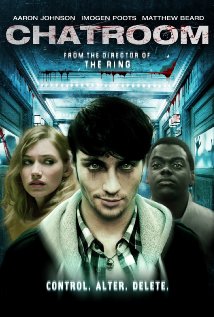
CHATROOM
UK, 2010, 97 minutes, Colour.
Aaron Taylor- Johnson, Imogen Poots, Matthew Beard, Hannah Murray, Daniel Kaluuya, Megan Dodds, Tuppence Middleton, Ophelia Lovibond, Richard Madden.
Directed by Hideo Nakata.
As might be expected from the title, this is about online sharing. However, it is a cautionary tale, especially for adolescents who have problems in themselves and at home.
While the story is British, focused on London, the director is the Japanese UK Nakata, best known for his Japanese films including Ringu and the American Ring 2.
Aaron Taylor- Johnson is a disturbed young man who sets up the chat room, Chelsea Teens. He is seen at his computer but it may be that all the events are happening in his head. (There may be some parallel with the experiences of Jason Statham in Guy Ritchie’s Revolver.)
What is significant is that the chat room is visualised, realistically and symbolically, long corridor, doors into various rooms, locked and unlocked, rooms which are empty, with different coloured walls, which various groups can occupy and share in. Much of the action concerns the group of characters who meet in this room. Some of them have an influence on William but he wants power over them, especially a disturbed young man who is suicidal, William giving him advice, setting him up with a gun, trying to drive him to death.
The film culminates in the young man’s crisis at the Zoo, and the group pursuing William to a canal lock, and he goes his death on train line.
1. The title? Expectations? Internet? The experience of being online, sharing? The focus on adolescents?
2. London, real, imaginary, Camden Lock, the zoo? The musical score, a tonal?
3. The visuals of the chat room, the realistic look, their being symbolic? The corridors, the doors of the box, the rooms in the space, the colours, emptiness, the difference when people were present? Chelsea Teens?
4. The moral issues, the warning of dangers about the Internet and chat rooms, families and difficulties, angers and resentments, revenge? Psychological states? Suicide?
5. William at the centre, his personality, his players? Creating the chatroom, his own computer, the visuals of his rooms? His activities, himself and his mother, her skill as a writer, his angers? The encounters with Eva and her influence, with Mo, Emily? His particular focus on Jimmy?
6. The interactions, venturing into the room, to the different rooms, their experiences within the rooms? Alternatives? Different sidings with each other?
7. William, sabotaging the rival site?
8. Jim, his psychological condition, very private, William and his advice, urging him on, pushing him, abandoning him? The support of the others in the group?
9. Emily, her parents, her resentment, vandalising their property?
10. Mo, the sexual issue, his attraction to the young girl, this being dramatised, his telling his good friend, the punch-up? The intimacy of these experiences and the consequences for Mo, for the girl?
11. Eva, model, wealthy, her reason for joining the group? Realising the truth?
12. At the zoo, gun, his being urged to suicide? The pursuit by the other members of the group?
13. Chase two the Camden Lock, the police, William’s last stand, falling onto the trainline, his death?
14. A London story, the Japanese perspective of the director and his career with horror films?
Published in Movie Reviews
Published in
Movie Reviews
Tagged under
Saturday, 18 September 2021 19:54
Unbroken
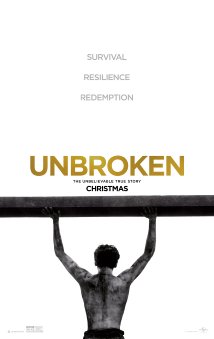
UNBROKEN
US, 2014, 137 minutes, Colour.
Jack O’ Connell, Domhnall Gleeson, Garrett Hedlund, Finn Witrock, Jai Courtney, Luke Treadaway.
Directed by Angelina Jolie.
Unbroken is based on the life story of Lou Zamperini, son of Italian migrants to the United States, who went on to acclaim at the 1936 Olympic Games, winning a gold medal in distance track, then a bombardier in World War II, prisoner in Japanese prisoner-of-war camps. While the narrative of the film ends in 1945, Zamperini had another almost 70 years of life, dying as late as 2014.
The film was directed by Angelina Jolie and has received mixed reactions from critics and audience, some of which, judging by the harsh spirit in which they were written, seem to be reviewing Angelina Jolie herself ( and alleged limitations) rather than her film. In fact, this is her second directorial film. The first was the unfortunately little-seen film, Land of Blood and Honey, a sometimes harrowing picture of the war in the Balkans in the 1990s, focusing on the treatment of women, abuse, rape, victimisation. Angelina Jolie seems to be interested in presenting the more harrowing aspects of life and of human nature.
This film is almost four films in one, the director showing a talent for an aerial warfare film, a sports film, a lost-at-sea film and a prison camp film. This means that it is quite demanding on the audience, an invitation to share in the continuing hardships of Zamperini, especially in the camps.
As a matter of interest, while the film setting is the United States and Japan, the film was made in Australia, most of it in Queensland.
The star of the film is the British actor, Jack O’ Connell, who gives the film his all and will probably ensure constant employment in films in the years to come.
The film opens with a close-up of a group in a bomber, going on a mission to do destroy a factory, set upon by Japanese fighter planes, the film showing the detail of the role of each man, pilot and co-pilot, bombardier, the approach to the target, opening the bomb bay doors, letting the bombs go, but coping with a Japanese attack, some of the men wounded, and the drama of a crash landing at the airbase on return. There is another aerial action sequence, but this time the mission is to find pilots adrift in the ocean, but after crashing into the ocean, three of the men find themselves adrift.
The aerial action is interrupted by flashbacks to Lou’s childhood, a cheeky and problematic child, from fervent Catholic family (with a sequence of homily by the parish priest about creation, the dark in the light, and being faithful to commitment). Fortunately, Lou’s older brother, Peter, a runner, takes Lou in hand, trains him, overcomes his low self-image and encourages him so that eventually he is chosen for the 1936 Olympic team (with the screenplay noting Jesse Owens’ achievement at those games).A winner, he has achieved a goal and developed his better self.
After this, the film moves into the lost at sea drama, three men surviving a crash into the ocean, over 45 days on life rafts, with few rations, trying to keep their minds active in conversation, fishing, surrounded by sharks (with a Jaws moment that makes us leap from our seats), being strafed by a Japanese plane. This is a close-up of the will to live, endurance and survival.
But there is still more demanding narrative. Zamperini and his friend, Phil (Domhnall Gleeson) are captured. The sequences are in the prisoner-of-war camp in Tokyo and then the prisoners removed towards the end of the war to work on the wharves, loading coal. While audiences are familiar with Japanese camps and the frequent cruel treatment, humiliations, brutality, there are some distinctive sequences here which bring into focus the treatment of prisoners by the cruel Japanese, a young sadistic commander who has not received the promotion he anticipated it has a fixation on Zamperini, and some moments trying to cultivate his friendship, even allowing him to broadcast on Tokyo radio to tell his parents that he was alive – though he refuses any collaboration for radio propaganda and is punished by the demand that every prisoner punch him in the face. He is frequently beaten, taunted by the commander, and made to hold aloft a wooden beam with the threat of execution should he drop it.
Life in the camp, its highs and lows, are brought vividly to life.
Woven into the screenplay (with famous writers and directors collaborating on it including the Coen brothers, Richard La Gravanese and William Nicholson) are issues of belief in God, the role of prayer, the nature of faith, and pledges to God for commitment after survival. The experiences of Zamperini dramatise the power of the human spirit, and its indomitability in the face of suffering.
Information is given at the end of the film – including the fact that Zamperini went back to Japan after the war, worked towards friendship and reconciliation (except for the commander who refused to meet Zamperini on his visits) and that forgiveness is all important.
1. A story? The indomitable spirit? The Louis Zamperini's, as a boy, young man, sports achievement, or endurance, post-war?
2. The title, Zamperini and his endurance? His whole life, dying at 97?
3. Angelina Jolie and her interest in this story, directing style? The group of writers and their contribution?
4. Four film styles in one: sport, aerial combat, lost at sea, prisoner-of-war?
5. The impact of the aerial sequences, the plane, crowded, the crew, the mission, the target, the dropping of the bombs, the Japanese plane attacks, injuries, Louis and his care, the bomb bay doors not closing, the danger, the decisions, the crash landing?
6. Insertion of the flashbacks about Louis, Italian family, migrated to America, family life, mother and the cooking and his watching her and the stern father, the difficulties of language, Catholic background listening to the sermon on the creation of light and dark? His shoplifting, mischief and name-calling by the boys, his being bashed, with the police? Peter and his skill in running? The challenge to Louis, training, and the success, competitions, skill, Louis chosen for the Olympics? The farewell to Peter, the family’s listening to the radio, the nod to Jesse Owens? His bowing into the Japanese athlete? His run and strategy review, winning gold?
7. The rescue mission, searching the ocean, going down, the deaths, the survivors and the rafts, the limited chocolate, the limited water, Mac and his attitudes, eating chocolate, issues of survival and death, the numbering of the days, the bird landing, their being sick fishing, nourishment, the circling sharks, the surprise Jaws moment, beating the record of number of days at sea, the attack of the sharks, heat, the effect on the men, the attack by the Japanese planes, shots, diving overboard? The rain? Talking to make sure that their minds worked? Mac and his death, Louis comforting him, putting his body to sea? And Japanese ship?
8. Prisoners of war, the bond between Louis and Phil, on the plane, Phil as the pilot, his decisions, at sea, his wound, his support? Being transferred to the sheds, isolation, Louis’s identity as an Olympian, humiliations, thinking they were to be executed, removing their clothes, being washed? The separation?
9. The camp, the commander, his personality, not having a promotion, having to supervise the enemy, his treatment, his language and English, his wanting eye contact with Louis, the flirtatious attitude, his bamboo and the beatings, taunting?
10. The situations of the men, in the dormitories, the range of prisoners in all, wanting to outlive the war and defeat the Japanese? The different nationalities?
11. The brutality, everybody subjected to it, the maps, radios, food, the Cinderella concert and impersonation, Louis and the invitation to speak on the radio, his message and text for his family, the offer to broadcast propaganda, the meals, his being tempted? His return, the commander and getting every soldier to punch him in the face? The seasons passing?
12. Moving camp, the seasons, the driving into the mountains, arriving at the wharves, loading the call, covered in soot, the men carrying the loads, the accidents and deaths, the new commander, the repeat of his attitude towards Louis, eye contact, making him pick up the beam and hold it, intimations of Christ figure? Louis and his defiance? The others willing him to succeed? All believing that they would die? The end of the war, the American planes?
13. Issues of religion, faith, prayer, promise to do good if surviving?
14. The return home, San Diego, family, the embrace?
15. Louis’s long life, almost 70 years more? Information about Phil’s wedding, Louis and his marriage, family? His returning to Japan? The theme of forgiveness? Meeting the guards, but the commander refusing to see him? As an old man running for the Olympics? His mission to forgive?
Published in Movie Reviews
Published in
Movie Reviews
Tagged under
Saturday, 18 September 2021 19:54
Revolver
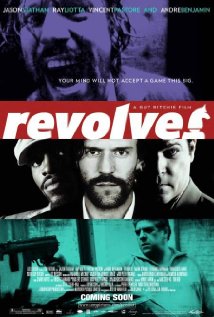
REVOLVER
UK, 2005, 111 minutes, Colour.
Jason Statham, Ray Liotta, Vincent Pastore, Andre Benjamin, Terence Maynard, Andrew Howard, Mark Strong, Francesca Annis.
Directed by Guy Ritchie.
When a director is well-liked and appreciated, critiques of his/her films are often more about the director than a review of the film itself. This is even truer when the director is disliked. Guy Ritchie has been treated in this way. He directed an unexpected hit with Lock, Stock and Two Smoking Barrels which led the way for umpteen imitations which irritated the critics. He did his own follow up, Snatch, which led to unfavourable reviews. Then he married Madonna and started a family which did led to further criticism. Then he made a film with her which was virtually unreleased, Swept Away, and that was considered the end of him. Now he has made Revolver which has received some of the worst reviews anyone would not want to see.
This is by way of prologue to saying that I found Revolver very interesting. My hunch is that the public will not like it, will find it far too difficult to understand and, as they say, stay away in droves. The other hunch is that if it had been released under the name of, say, an unknown Eastern European film-maker in an art-house cinema, it would have received respectful and possibly rave reviews for its innovation, for its blend of fantasy and reality and for its psychological explorations!
Revolver is something of a misleading title. Yes, there are guns in the film. Ritchie, however, wants the title to have more existential overtones, that everything that happens comes round again. That is probably the clue. This is an existential, psychological drama set in the world of criminals.
The criminal world is a mixture of London’s Soho and Las Vegas. There are $12 notes. Half the cast is British and have British accents, half are American with American accents. This is an invented territory that should give us some clues to the unreality we are watching. The other clue is that there is constant voiceover and commentary by the central character, Jake Green (Mr Green in echoes of Reservoir Dogs). He is played by Ritchie’s friend, Jason Statham, who in films like The Transporter series plays very stolidly indeed. He is much better as Mr Green. Ray Liotta gives what seems at times to be a hammy performance until we realize who he really is.
It would be interesting to pinpoint the moment in the film where the audience realizes that everything is happening inside the head of Jake Green, that he is not only schizophrenic with paranoid fears but that his psyche is multiple personality. It is this key element which could baffle audiences thinking they were watching a straightforward gangster movie (although the successful Fight Club did something similar).
So, for those who like the film, which is stylishly photographed with some tricksy angles and editing, and are able to accept its sometimes overwrought manner and rhetorical dialogue (especially at the end when the personalities start arguing with each other), there is plenty to think about in terms of action, responsibility, self-delusion, self-destruction and identity. At the beginning Ritchie also includes captions with quotations about enemies, war and confidence tricks and re-inserts them throughout the film.
For those who are not put off by the negative reviews, intriguing.
1. The title? Guns? Revolving?
2. The locations, the blend of the British and American city? The streets, the casino, apartments, luxury, offices? The blend of the real and the surreal?
3. The musical score, the use of music classics?
4. The narrative, the voice-over? Jake, his voice, other voices intruding, psychological state? Two Jakes?
5. The action in his head, real, imagined, created? The moral conflict? The psychological conflict?
6. The quotes throughout the film, on psychology, the psyche, identity, enemies, outsmarting enemies, sophisticated enemies, intimations of suicide?
7. The use of chess, the chessboard, interactions and play? Symbolic?
8. Jake, getting out of prison, h or is being framed, serving seven years, Mancha and his comments?
9. Jake and his psychological state, wanting revenge, linking up with his friends, going to the casino, sitting down defiant? Wanting to see Macha, going into the room, the confrontation, Macha? Gambling, flipping the coin, getting the money, his knowing how to play games, the rules of the game?
10. Macha, his status, wealth, the casino, the henchmen, in action, violent and brutal, his moods? Paul, his advice, orders? The money? The luxury bed, in the solarium, with the women? His wanting to move the drugs? The contact with Mr Gold, the elaborate room and the art work? The enigmatic Ms Walker? His failure to get the drugs, the switch, wanting to contact the Chinese? The failures? Building up to Jake, the confrontation, the voices in Jake’s head, real or not? The identity of Mr Gold? The role of Miss Walker? Macha and his talking about fear and becoming afraid?
11. Sorter as the assassin, his ability to hit, his missing? Seeing him in action? The child in the cupboard? His shooting through the walls and the roof? His change in attitude, because of the child, his death?
12. The Chinese, the characters, drugs, the seductive girl? The boss? Confrontations and killings?
13. Jake, Billy, love for his daughter, giving support to Jake, his being taken, hiding the daughter in the cupboard, his hand being impaled?
14. Jake and his time in prison, in isolation, the two men in the cells each side, his explanation, communication with them, the chess moves, their disappearance?
15. The two men, their appearance, American style, their hold over Jake, control, the characters, getting the money, the loans, taking Jake’s money, his collecting it from the security box, confrontations and the effect? The clients, violence, deaths?
16. Audience realisation that the two with this hold were the two from the prison?
17. All this happening in Jake’s head, where is Jake in reality – still in prison? The confrontation with Macha, his lying on his bed, the arguments, the gun, the issue of fear?
18. Ultimately who is Jake, where is he, physically, psychologically?
Published in Movie Reviews
Published in
Movie Reviews
Tagged under
Saturday, 18 September 2021 19:54
Condemned, The
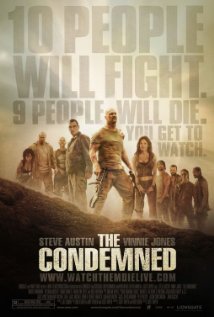
THE CONDEMNED
US, 2007, 113 minutes, Colour.
Steve Austin, Vinnie Jones, Robert Mammone, Victoria Mussett.
Directed by Scott Wiper.
Gladiatorial contests were popular 2000 years ago and, in one form or another, have continued to be popular. Warriors, or victims, are placed in an arena to fight to the death. Only one survivor.
This theme has been taken up by a number of films, including Gladiator and modern stories with the same title. It is used in Turkey Shoot, with the 2014 version going to the arena of reality television. This is the case with this film, once again reality television, available online, aiming for millions of viewers, battle to the death. In a more upmarket film, The Hunger Games, the same theme is used but for political satirical purposes.
While the film has an international setting, it was filmed in Australia, giving opportunity for some Australian actors, especially Robert Mammone, who has a significant role as the callous young entrepreneur, with too much money, who organises the games for The Condemned. The hero of the piece is action star (rather than actor), Steve Austin, a big strong determined presence. And the villain in the fights, is ex-British footballer, Vinnie Jones. A number of international actors form a group of 10 who are to fight to the death, everything being filmed and broadcast live, from Japan, Central America, the US, including a black fighter.
All the chosen fighters have been condemned to death for killings or other atrocities. The film opens with the entrepreneur looking at the treatment of a prisoner from Belarus whom he immediately hires. When an American prisoner comes on line and he researches his background – and then alters the biography completely – he hires him. This is Steve Austin, but he has this Secret Ops background which has required him to be imprisoned in Central America for year, some of his authorities in the US not wanting him released. There are scenes of his family background in the US which gives the film a touch of the poignant. Two of the captors have a Hispanic background, a husband and wife and the film focuses somewhat on their relationship and their helping each other to survive.
This is the kind of film that has its cake and eats it as well: a television interviewer discusses the whole process with the entrepreneur, condemning it as immoral. She appears at the end of the film, commenting that immorality is part of the morality of the viewers who watch this kind of thing. During the program, the female assistant continues to object to the games, wanting them stopped, but the entrepreneur refuses. His main technical man also makes objections, saying that he has crossed the line, but ultimately he submits.
By the end, it is Steve Austin versus Vinnie Jones in some bone-cracking, harsh violent encounters. Just when Jones thinks he has won and proceeds to slaughter everybody in the production team, it emerges that Steve Austin is still around, the build-up to get another final confrontation. In the meantime, the entrepreneur tries to make his escape by helicopter.
While the contest is a fight to the death, each of the warriors has a mechanism on their leg for explosions when they are killed or when they exceed the time limit for the contest. In a kind of poetic justice, Steve Austin loosens his tag and throws it into the helicopter, destroying the entrepreneur.
And it all ends happily with Austin returning to loved ones.
Audiences who would look online at such a program will enjoy this film. There are some challenges to conscience. Otherwise, the story and the execution are probably too brutal for the average audience.
Published in Movie Reviews
Published in
Movie Reviews
Tagged under
Saturday, 18 September 2021 19:54
Sgt Bilko
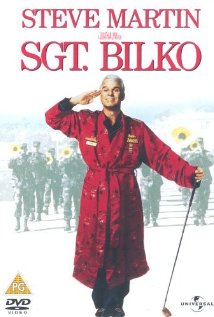
SGT BILKO
US, 1996, 96 minutes, Colour.
Steve Martin, Dan Aykroyd, Phil Hartman, Glenne Hedley, Daryl Mitchell, Austin Pendleton, Chris Rock.
Directed by Jonathan Lynn.
One of the problems of not seeing so much television during the late 50s, early 60s is that we missed out on a lot of television programs that are now considered classics.
They say that Phil Silvers' show, Sgt Bilko, was one of the best. I don't think they'll be saying this about this movie. Perhaps it was Phil Silvers' comic style that enabled him to get away with all kinds of con stunts in the army. Though Steve Martin is a clever comic, I found I was more in sympathy with the uptight officer who was the victim of Bilko's pranks. In fact, we are meant to be applauding Bilko and his troop.
When the writing is witty and there is satirical intention, this can work. But this is all straightforward and types that would drive you mad in real life become heroes. And the director is Jonathan Lynn, the co-writer and director of Yes Minister. A sour comedy.
1. The popularity of the television series? In its time? Considered a classic TV show?
2. Remake in the mood of the 1990s, drawing on the old series, being contemporary?
3. Steve Martin, his screen presence, his style? In comparison with Phil Silvers?
4. Fort Baxter, the usual layout of a military base, offices, the common room, the motor pool section? And the conversion of the motor pool into a club?
5. The satiric tone, the one-liners, the situations? The touch of the slapstick?
6. Sgt Bilko and his role, his history, the clashes with Thorn, Thorn arriving and against him? Seeing Bilko in action, smelling the money, selling the tickets, the cover for information on the radio, the range of deals, smart, his followers, blindly following him, admiring him, his using them? Concealing the setup from the commanding officer?
7. How funny his exploits – and exploitation? lies, coverup?
8. The commander, pleasant, rather ignorant, believing Bilko, glad about his keeping up morale, his wife, his house and garden? Inspecting the men? Going to the car pool, the winding back of his odometer? His not suspecting? The visit, the officer, exposing the limitations of the base, fears of the base was closing down? The test for the hovering tank? The results?
9. Rita, waiting at the altar, everybody leaving, playing cards? This happening over and over? Her setting up a situation with Thorn, going out with him, challenging Bilko, his jealousy? At the end, the wedding – happy ending or not?
10. Water arriving, by the book, his observing Bilko, not liked by the other men, at the end offering a solution for the demonstration of the tank?
11. Thorn, the past, his anger, staying, tangling with Bilko and Bilko being shrewd? With Rita, the outings, trying to get back at Bilko? The demonstration, his examining the machine, taking the piece, accusing them of faking the demonstration? His comeuppance?
12. The engineers for the tank, exasperation, $70 million, the surprise when it seemed to work? The explosions engineered, and the canon facing the wrong way…?
13. The inspectors, their partnership, decisions about the base?
14. How comic this kind of picture of an exploitative Sgt and his getting away with everything?
Published in Movie Reviews
Published in
Movie Reviews
Tagged under
Saturday, 18 September 2021 19:54
Wyrmwood: Road of the Dead
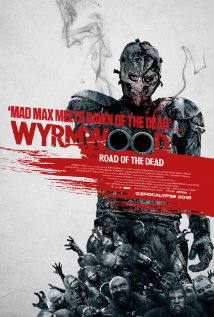
WYRMWOOD: ROAD OF THE DEAD
Australia, 2014, 98 minutes, Colour.
Jay Gallagher, Bianca Bradey, Leon Burchill.
Directed by Kiah Roche- Turner.
With an outt-and-out zombie movie, it is not too helpful to compare to other movies, especially mainstream, except other out-and-out zombie movies. Wyrmwood: Road of the Dead is definitely and out-and-out zombie movie.
The surprising thing is that it is an Australian film, made in and around Sydney for a small-budget by two brothers, who wrote the screenplay, with Kiah Roche- Turner directing and doing all kinds of technical things including editing, with his brother Tristan producing, doing all kinds of things as well, and even turning up as a zombie extra. The other surprising thing is that Screen Australia also contributed to the production. And, if the response of the fans is any indication, the film should make its money back – and then some…
For a lot of the time, as we focus on the hero, Barry (Jay Gallagher) as he takes the road fighting off the zombies, experiencing his wife and daughter turning, hoping to rescue his sister, Brooke (Bianca Bradey), he is certainly reminiscent of Mel Gibson as Mad Max. It seems that the brothers were keen to make a Mad Max film and they have succeeded. They have also declared an interest in films by George A.Romero, like Dawn of the Dead and wanted to incorporate that with Mad Max.
It takes very little time to introduce the audience to the zombies, no explanations, they are just there, looking their ugly best, on the rampage to destroy humans. There is also a group of military men in masks, who seem to be on the side of good, but throughout the film a fairly aggressive, the suggestion being that they are cautious about the spread of the plague.
As might be expected, there is quite a lot of firepower, up close and personal, as the zombies attack, are repulsed, are slaughtered.
But, there are some personal aspects of the plot. Brooke is involved with some artists but the studio is invaded and she is the only survivor, captured, put in a van with a number of characters, some of whom have turned, with a scientist, a scientist with the touch of the mad, who is keeping her alive and doing tests on her. it takes a while, but she does escape and meet up with her brother, Barry, the mechanic. He seems to have been leading a happy life at home and at work, loving wife and daughter, but when somebody is in the house at night, he evacuates them, goes on the road, only for them to turn and for him to try to survive first with his car which breaks down, then with a truck which, it is revealed, runs on zombie energy and requires a live zombie (so to speak) as an engine to keep the vehicle going!
Barry meets up with some anti-zombie fighters, but they are dubious characters and there is more Mad Max action on the roads. Barry is relentlessly tough and withstands a lot of fighting, slashing, bullets.
Then he meets up with an aboriginal character, Benny (Leon Burchill). Benny had appeared early in the film with some aboriginal friends who are chased through the bush by zombies, and he lives to tell the tale. Despite initial appearances, Benny has survived, and joins with Barry with the pursuing zombies turning on them (perhaps the first zombie film with aboriginal characters!).
This is a film for zombie fans only, audiences coming in from the outside may find it too much fairly early in the piece and bow out. But, for those who are fans, it is well done of its kind, given the limited resources, and it is a more imaginative turn on the zombie genre than usual.
Published in Movie Reviews
Published in
Movie Reviews
Tagged under
Saturday, 18 September 2021 19:54
Dumb and Dumber To
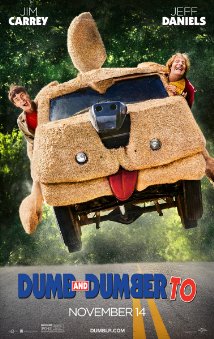
DUMB AND DUMBER TO
US, 2014, 109 minutes, Colour.
Jim Carrey, Jeff Daniels, Rob Riggle, Laurie Holden, Rachel Melvin, Kathleen Turner, Bill Murray.
Directed by Bobby Farrelly, Peter Farrelly.
If you wait long enough, something might happen. 20 years is a comparatively long time in film history, and a lot of those lining up at the box office to see this comedy were not even thought of when the Dumb and Dumber first came out. Those who laughed, some unashamedly, some with embarrassment, in those 90s days might line up for this one and find it more than a touch embarrassing! Of course, the writers-directors, the Farrelly Bros, intended this.
For those who wonder how they enjoyed the dumbness on screen in the 1990s, but will be hard put to explain why the present film has been made and what audience it will attract. The good news is, if you wait right until the end of the credits, and watched the final gag, a card comes up which announces Dumb and Dumber For. But it adds the information that this sequel is due for release in 2034! Why not! The stars will be in their 70s, the fans from the 90s will possibly be in their 50s (or more) and the young kids who laughed loudly and delightedly during the screening will be into their 30s – or, for quite a number of them, approaching 30.
Jim Carrey and Jeff Daniels back again. Jim Carrey not having had such a successful career in recent years seems to be putting extra effort into his traditional mugging, to make sure that nobody makes a mistake about his interpretation of Lloyd. Jeff Daniels has had a strong career both before Dumb and Dumber and afterwards, including a top televisions, The Newsroom. He seems far more relaxed in this film, being a good sport, still game enough to play the mop head (awry) Harry and expose himself to his public, in more ways than one.
Lloyd has been in an institution for 20 years, immobile, not responding – and suddenly he explains why. Harry has been visiting in the 20 years and looking after him, and surviving who knows how – and we realise that they have continually played games of Gotch on each other! They go to see Harry’s parents, Koreans who adopted him, and he finds in his mail, a letter 20 years from on an old flame, Frida Filcher (a game Kathleen Turner) who tells him that she had a daughter.. He assumes it is his (and with the revelation at the end of the film, it is a wonder that he and Lloyd could have thought this) and, since he says he has been diagnosed as needing kidney transplant, he and Lloyd go off to find the girl, and a potential kidney.
One joke is that they arrive back at Frida’s house because in their search, Harry had looked only at the back of the envelope with the return address instead of where the letter had been sent! That is one of the funnier jokes for an adult audience. The rest of the film is full of dopey interchanges between the two, elaboration of their dopey characters, lots of pratfalls, lots of slapstick, lots of bodily function junction innuendo and situations, and behaviour like 10-year-olds (with apologies to most 10-year-olds). The comedy is for some guffaws, especially from the 10-year-olds in the audience (which happened).
The finding of the daughter is not too difficult after the initial stupidities, and it is revealed that she has been adopted by a top scientist who was about to go to a convention in El Paso to receive an award and to offer, in a box, hope for the future of the human race. The daughter certainly does not look anything like Harry, is more like Lloyd and behaves a bit like him – the scientist’s intelligence does not seem to have rubbed off on her. But, the scientists is married to an avaricious wife who wants his money, especially from his science insights, and conspires with the handyman to get rid of him – but, since the daughter left the important box behind, he has to travel with Harry and Lloyd, leading to a whole lot of dumb and dumber situations and practical jokes -and attempted murder.
There are some twists at the end of the film, especially with Kathleen Turner turning up to meet her daughter. And the paternity issue is solved.
There was some years back a prequel called Dumb and Dumberer. This does mean that Dumb and Dumberest was available as a title for this film. It would have been most suitable as it turns out. So, who is the film for? Nostalgia for the middle-aged? But they will realise that they have moved beyond Harry and Lloyd. For the younger audiences, probably – but they will now have to wait another 20 years for their moments of disillusionment.
That’s it: a film in which we can release our dopey inner child!
Published in Movie Reviews
Published in
Movie Reviews
Tagged under
Saturday, 18 September 2021 19:54
Jane Eyre/ 2011

JANE EYRE
UK, 2011, 120 minutes, Colour.
Mia Wasakowska, Michael Fassbender, Jamie Bell, Judi Dench, Sally Hawkins, Simon Mc Burney, Holliday Grainger, Tamzin Merchant, Amelia Clarkson, Craig Roberts, Imogen Poots, Sophie Ward, Valentina Cervi.
Directed by Cary Joji Fukunaga.
Jane Eyre and Wuthering Heights, both published in 1847, by Charlotte Bronte and Emily Bronte, with male noms-de-plume, have become English classics as well as the sources for many film versions. Here is a 21st century version. It is directed by an American, Cary Fukunaga whose other feature film was Sin Nombre, a look at migrants from Central America heading for the United States.
We are immersed in the world of Yorkshire, moors, crags, dales, the isolation, the seasons. The atmosphere is very realistic. However, this is a 19th century Gothic tale of a mansion, dark corridors, vast rooms and eerie sounds from a sealed part of the house. But it is also Dickensian in its picture of orphans treated badly by hostile relatives and, even worse, in an orphanage school with canings on the back and a headmaster with a hell and damnation approach to discipline. Jane suffers all this.
When she obtains a position as governess at Thornfield, the mansion of Edward Fairfax Rochester, she bonds with the housekeeper, Mrs Fairfax, and her French student, Adele, the past can be forgotten.
However, the film starts with Jane alone on the moors, running away from Thornfield, drenched on the carriage tracks and finally collapsing at a rectory where she is taken in and cared for by a minister and his sisters. It is from the rectory that the events of Jane’s childhood and in the orphanage are seen as flashbacks. When she recovers, she remembers all that happened at Thornfield, of her encounter with the enigmatic and severe Rochester, watching his courtship of a neighbour, Blanche Ingram, then finding that he proposes to her and that she loves him. But, most audiences probably know already what Rochester’s secret is and how it will ruin Jane’s marriage.
Mia Wasikowska (who was Tim Burton’s Alice in Wonderland) is a young, rather plain and reserved while assertive, Jane. Though she sometimes looks impassively stoic, she has invited us into her heart and mind so that we know what she is thinking and feeling. Michael Fassbender seems a younger Rochester (though he was five years older than Orson Welles was when he was Rochester in the 1943 version), dashing and, as Jane says, abrupt. Judi Dench plays the housekeeper with great warmth. Jamie Bell is the Reverend St John Rivers, a mature presence reminding us that his Billy Elliott and other juvenile roles are over. There are cameos from Sally Hawkins as Mrs Reid, Simon Mc Burney as the righteous Henry Brocklehurst and Valentina Cervi as Bertha Mason.
Most audiences will enjoy Jane Eyre, even if they have seen other versions (with Joan Fontaine, Susannah York and Charlotte Gainsbourg and Orson Welles, George C. Scott and William Hurt). It is both austere and emotional.
1. The continued popularity of the novel, considered a classic? The various versions in cinema, television? Audience awareness of the book, the plot?
2. Fidelity to the novel, the plot and development of characters, its spirit? As drama for the 21st century?
3. The locations, the countryside, the residence of the Rivers’ family, Thornfield, the interiors of the homes, the school? 19th century costumes, decor? Musical score?
4. The introduction to Jane, young, through the harsh weather, in the fields, arriving at the house, the family giving her care, the sisters, St John Rivers, his character, welcoming, the touch of reticence? Getting Jane a job, teaching, the prospects?
5. The flashbacks, Jane as an orphan, with Mrs Reed, and Dickensian and harsh character, her family? As the school, the harshness of Mr Brocklehurst? The effect on her?
6. At Thornfield, the friendship with Mrs Fairfax, a good woman, her work in the house, helping Jane? Teaching Adele? Her French background?
7. Rochester, his first appearance, dramatic, of the horse, his fall? Jane helping him? His character, basic, severe, anguished? The bond between himself and Jane? The conversations, love? The fire and her rescuing him?
8. Miss Ingram, a 19th century young woman, the prospects of marriage? Jane expecting Rochester to propose to her? His proposing to Jane? The impact of the visitors, the story about Rochester, his marriage?
9. Rochester, the dramatic situation, admitting that he had a wife, the recounting of the story, the truth, his being tricked into marrying her, madness, in the attic, the violence, the servants taking her meals, the sounds throughout the house and their effect?
10. Jane, came back to the Rivers’ household, St John Rivers, the teaching, his proposal, wanting her to be his missionary wife? Her turning him down?
11. The return to Thornfield, the house burning down, Bertha and her death? Rochester and his blindness, Jane and her care, their love, their future?
Published in Movie Reviews
Published in
Movie Reviews
Tagged under
Saturday, 18 September 2021 19:54
Flintstones, The

THE FLINTSTONES
US, 1994, 91 minutes,. Colour.
John Goodman, Elizabeth Perkins, Rick Moranis, Rosie O' Donnell, Kyle Mac Lachlan, Halle Berry, Elizabeth Taylor, Jonathan Winters, Harvey Korman.
Directed by Brian Levant.
Whether it was a good idea or not to make a live action version of the very popular television cartoon series, The Flintstones, is a debatable point. But, the producers have made it and there it is for enjoyment.
Much of the enjoyment comes from the performances of the central cast, the similarities in look, clothes, manner, way of speaking to the cartoon characters. John Goodman fits the bill as Fred Flintstone and his Yabba Yabba Doo. Rick Moranis is a quiet foil for Fred. Elizabeth Perkins is Wilma and, surprisingly, Rosie O’ Donnell is Betty.
It is very entertaining to see all the parallels between contemporary living and that of the Stone Age, everything up to date with Stone Age vehicles, Stone Age cinema, shops… There are visual jokes and verbal jokes to keep the audience alert and entertained.
There is a family story, especially that of Barney and Betty and their adoption of a little boy, a tough character called Bam-Bam?. The poignant touch is that Fred has supplied the money for the process.
And there are the villains, Kyle Mac Lachlan and a glamorous Halle Berryiley plotting to get profit from the workers and getting a stooge to take the fall – Fred, of course,
There was a sequel in 2000, The Flintstones, Viva Las Vegas, this time with Mark Addy as Fred and Stephen Baldwin as Barney. Both films were directed by Brian Levant.
1. The popularity of the cartoon, watching it on television? Comparisons with the Live Action version?
2. Audience response to the Stone Age? The conventions of the cavemen, families, lifestyle, dominance of the men…? Cave illustrations?
3. Bedrock, the names associated with the stones and rocks, the companies? The equivalent of 20th-century living, the cinema, cooking, the taxis and people using their feet…? The humour in the comparisons? The prehistoric animals?
4. Fred and Barney, the friendship, the families, working together, the wives, the children, the adoption, going to the agency, Bam-Bam? and his being accepted into the family, with the Flintstone’s daughter, playing together? The process of adoption, Fred giving the money? Fear of Wilma? Her praising him for his kindness?
5. The details of the work, with the stones, the bird and time to finish work…?
6. Cliff Vandercave, Miss Stone, the plotting, the plan, his deviousness, her glamour? Looking for a stooge, choosing Fred? Cliff and his speech to the workers, the promises? The exam, Fred doing badly, Barney’s answering the questions in gratitude? Fred being framed, people turning against him, his not realising the situation, his reaction to Barney and Barney’s reaction?
7. The background of ordinary things, sequences, children, pets, meals, play?
8. The revelation of the truth, Fred and the exam, his job, feeling bad? Barney and the reconciliation?
9. The confrontation, Cliff, Miss Stone and her confessing? The collapse of the stone, covering Cliff, his becoming a statue, the manager and his wanting to keep the statue, restore the work, Fred and Barney and things back to normal?
10. The entertainment value and cartoon characters and situations coming alive?
Published in Movie Reviews
Published in
Movie Reviews
Tagged under